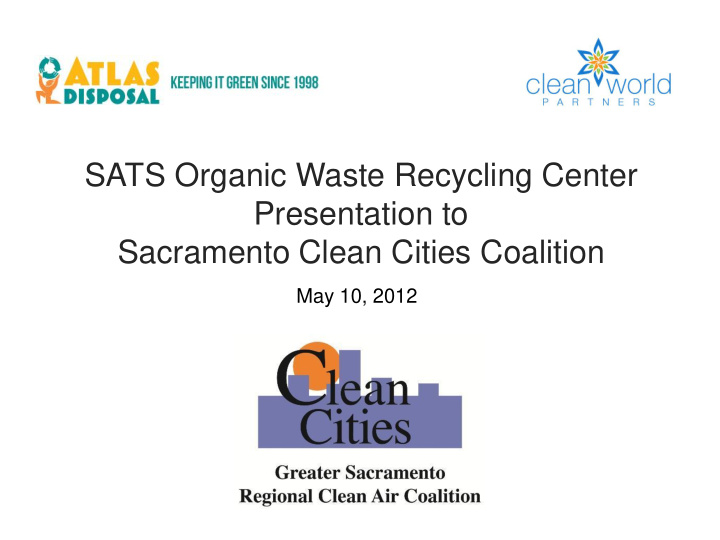



Advancing Applications. Partnering for Success. SATS Organic Waste Recycling Center Presentation to Sacramento Clean Cities Coalition May 10, 2012 SATS Organic Waste Recycling Center
Presentation Outline • Overview on Organic Waste • Atlas Disposal Services • Clean World Partners • SATS Project Overview • Goals and Objectives • Timelines slide 2
Food Waste in US (EPA, 2006) • Amount of food scraps – 44 million tons per year – 25% food prepared • Cost of disposal – $1.1 billion per year – $25 per ton • Current method of management – 97% disposed in landfill – 3% recovered for composting or combustion
Organic Waste Examples Crop Residue Green Waste Food Processing By- Product Food Leftovers
Organic Waste • Nature breaks it down – Grass on the street – Creates CH4 (methane) in absence of air • Emissions 23 times more harmful that auto – Lighter than air, hotter & burns more quickly – Landfill organics characterization 15% food, 13% green and 11% non-recyclable paper • Government increasing regulation “push” • Private sector sustainability plans “pull” • Customers making buying decisions based on environmental compliance 5
Regulators Know the Effect of Organics • Moving material away from landfills – CA AB 939 (1989 50% diversion law) – CA AB 341 (2011 75% diversion goal) – CA considering organics ban – CA AB32 GHG reduction law • Connecticut food diversion (104 tpy) mandate • Massachusetts ban likely in 2012 • CARB LCFS pathway for food and green waste digestion waste likely soon – may be a negative carbon intensity number slide 6
Who is Atlas Disposal Services Since 1998, we deliver technology, innovation and service to efficiently and cost effectively process waste materials into renewable resources. slide 7
Atlas Firsts • Construction and Demolition Facility in Sacramento • Fleet Powered by Clean Fuel • Began replacement in 2008 • 14 CNG Powered Trucks operated today • Commitment for 100% by 2016 • Partnership for AD Technology to Create Transportation Fuel slide 8
Who is Clean World Partners? • Provider of waste technology solutions that – divert waste from landfills – capture harmful GHG emissions – create renewable energy, soil amendments, and other useful byproducts • Systems Integrator- Best of Breed partner technologies that maximize AD performance and provide a complete solution • Commercializing proprietary anaerobic digestion technologies – Technology inventor, Dr. Zhang, is a world-renowned scientist from UC Davis • A subsidiary of Synergex International Corporation, an industry leader at the forefront of technology for over 35 years
Anaerobic Digester Technology • Series of processes in which natural microorganisms break down biodegradable material in the absence of oxygen and produce gaseous products, including methane, carbon dioxide, and small amounts of hydrogen and hydrogen sulfide. • The basic AD technology is used in thousands of locations throughout the world. In the US, it is primarily used for dairy and livestock waste, which are predominantly liquid wastes. • Building on the base AD technology, our technology advisor, Dr. Ruihong Zhang of UC Davis, patented solutions to some of AD’s remaining limitations relating to processing and handling of high-solid material. CWP has the license to commercialize the technologies. 10
The Clean World Partners Advantages • Products built affordably and efficiently at a scale that allows AD facilities to be located on site • Proven success with operating facilities • Experienced leadership team with extensive technical and business expertise – Experienced technically with years of experience developing new technologies, productizing them, and introducing them to broad international markets – Experienced in developing companies from start up phases and leading them through to high performance companies solving customer problems
CWP Technology Differentiators • Two- and three-stage digestion systems that offer first stage sequential batch loading and continuous gas production – Allows for high system stability regardless of fluctuations in loading and waste composition – Provides even gas production and rapid waste digestion • Mesophilic and thermophilic temperature options • Built for treating high-solid (10 - 50% total solids) waste streams (MSW, Food, Agricultural and processing) • Advanced instrumentation and control systems allow remote monitoring and operations • Material separation technology allows for contaminants • Material doesn’t need to be liquefied (goes directly in vessels) • Smaller tanks, less water = lower capital and operating costs slide 12
CWP Current Facilities American River Packaging: Packaging manufacturer with corrugated waste • 8 tons per day (.5 cardboard and 7.5 tons food waste) • System size 10 tpd (accounting for paper absorption) • Producing 1300 kWh per day of electricity with micro- turbines for use on site • Food waste coming from local food processors slide 13
American River Packaging 14
ARP Organic Waste Recycling Center slide 15
CWP Current Projects – Atlas SATS Atlas Disposal: Waste hauler who operates a food collection program in Sacramento County • 25 tons per day food waste – Pre- and post-consumer food waste collection program • Producing CNG to fuel Atlas’ fleet of 14 CNG trucks • Sophisticated preprocessing system – Separating 8 tpd of Campbell’s Soup packaged waste – Other contaminants • Opening July 2012 slide 16
SATS Sacramento Bio Refinery slide 17
South Area Transfer Station 18
Atlas SATS Process Flow Diagram 19
slide 20
Goals and Objectives • Develop organics infrastructure in Sacramento • Scale CWP’s technologies • Grow Atlas’ food collection program • Build CNG station for public use • Create clean RCNG to fuel Atlas’ & other fleets • Create valuable soil enhancement products that can replace crude-based fertilizers • Scale system up to 100 tpd and higher • Set an environmental standard slide 21
SATS Project Timeline • Start construction (April ‘12) • Complete 25 tpd project (July’12) • Begin processing waste (July ‘12) • Full gas production (November ‘12) • Work with Sac County & Partners to scale up to 100 tpd (2 nd Qtr. ‘13) • Complete 100 tpd facility. (2013?) • Begin fueling community RCNG (Late 2013?) slide 22
Recommend
More recommend